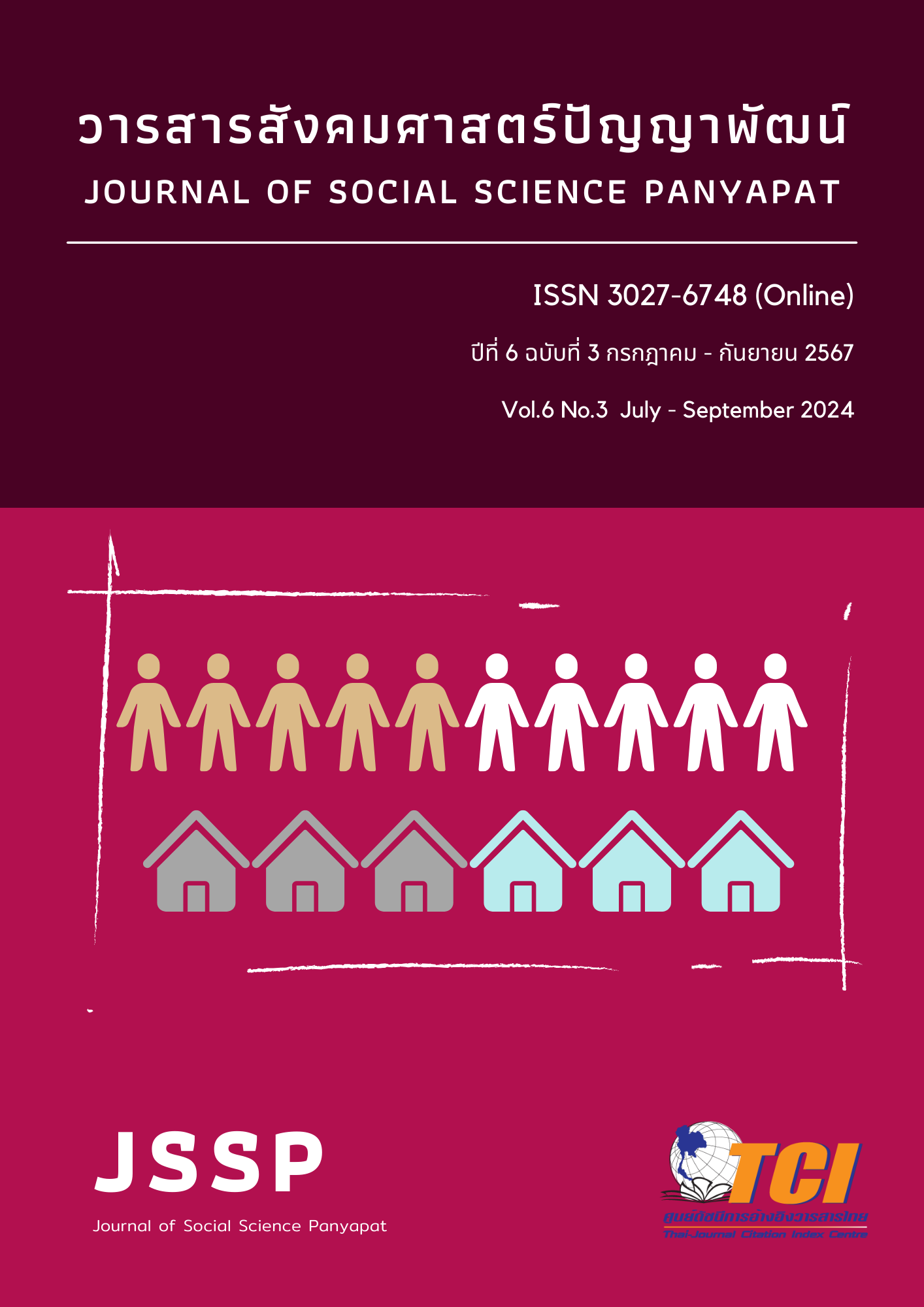Comparisons of The Academic Achievement Regarding Learning About Thai Sentence Structure of Second Year Secondary Education Students Between A GPAS Learning Management Method and Conventional Instruction Methods
Keywords:
Academic Achievement Regarding Learning about Thai Sentence, A GPAS Learning Management Method, Conventional Instruction MethodAbstract
This research article aimed to (1) compare the average score of the academic achievement of the secondary school students prior to and after learning by following a GPAS method, and (2) compare the average score of the academic achievement of the students between experimental and control groups. The target population was 60 students who studied in year-2 secondary school level in the second academic year 2022 at Pipattanasuksa (pseudonym), Nakorn Nayok province in Thailand. Each group comprised 30 students. Both groups were divided by using a purposive sampling method to experimental and control groups. The experimental group was taught following GPAS method and the control group was taught through conventional teaching methods. Research instrument for collecting data was an academic achievement test regarding learning about Thai sentence structure. The test was a multiple-choice test which consisted of 30 items. The test had content validity between 0.80-1.00, reliability as 0.76, difficulty as 0.34-0.72, and discrimination between 2.16-7.03. The instruments for the experiment were 6 lesson plans designed following GPAS method and 6 lesson plans designed though conventional teaching methods. Each lesson plan designed for a teaching session, comprised 50 minutes. The research was undertaken for 3 weeks, 3 sessions per week. Quantitative data were examined to check average score and standard deviation. Additionally, the results were analyzed to check statistical significance by using t-test. The findings showed that the average score of academic achievement of experimental group was higher than prior to the experiment at the 0.05 level of significance, and the average score of academic achievement of experimental group was higher than control group after the experiment at the 0.05 level of significance.
References
กระทรวงศึกษาธิการ. (2551). หลักสูตรแกนกลางการศึกษาขั้นพื้นฐาน พุทธศักราช 2551. กรุงเทพฯ: โรงพิมพ์ชุมนุมสหกรณ์การเกษตรแห่งประเทศไทย.
กาญจนา นาคสกุล. (2546). ปัญหาการใช้ภาษาไทย. วารสารราชบัณฑิตยสถาน, 1, 244-258.
ฐะปะนีย์ นาครทรรพ. (2553). สอนหลักภาษาไทยอย่างไรไม่น่าเบื่อ ใน ศาสตราจารย์กิตติคุณ ฐะปะนีย์ นาครทรรพ(บรรณาธิการ), วรรณศิลป์ในดวงใจ ภาษาไทยที่รัก. (น. 384-389). กรุงเทพฯ: อัมรินทร์พริ้นติ้งแอนด์พับลิชชิ่ง.
ทิศนา แขมมณี. (2566). ศาสตร์การสอน: องค์ความรู้เพื่อการจัดการเรียนรู้ที่มีประสิทธิภาพ. (พิมพ์ครั้งที่ 23). กรุงเทพฯ: จุฬาลงกรณ์มหาวิทยาลัย.
เทวราช มังคะละ. (2565). การพัฒนาความสามารถการอ่านเชิงวิเคราะห์ด้วยการออกแบบการเรียนรู้แบบย้อนกลับร่วมกับการจัดการเรียนรู้ด้วยกระบวนการคิดขั้นสูงเชิงระบบ (GPAS 5 Steps) สำหรับนักเรียนชั้นมัธยมศึกษาปีที่ 3. (ศึกษาศาสตรมหาบัณฑิต, มหาวิทยาลัยนเรศวร).
บรรจบ พันธุเมธา. (2562). ลักษณะภาษาไทย THA1001. (พิมพ์ครั้งที่ 24). กรุงเทพฯ: มหาวิทยาลัยรามคำแหง.
พงษ์พิรุณ วดีศิริศักดิ์. (2563). การพัฒนาความเป็นพลเมืองใส่ใจสังคมและผลสัมฤทธิ์ทางการเรียนวิชาวิทยาศาสตร์ของนักเรียนชั้นประถมศึกษาปีที่ 5 โดยใช้กระบวนการเรียนรู้ 5 ขั้นตอน. (การศึกษามหาบัณฑิต, มหาวิทยาลัยศรีนครินทรวิโรฒ).
ยุวรัตน์ นักทำนา, นารี คูหาเรืองรอง และ เลอลักษณ์ โอทกานนท์. (2563). การจัดกิจกรรมชมรมดนตรีสร้างสรรค์โดยใช้แนวคิด GPAS 5 Steps เพื่อพัฒนาทักษะกระบวนการคิดสร้างสรรค์สำหรับนักเรียนระดับชั้นมัธยมศึกษาตอนต้น. วารสารวไลยอลงกรณ์ปริทัศน์ (มนุษยศาสตร์และสังคมศาสตร์), 10(3), 1-18.
วะรุฬพันธ์ โหม่งมาตย์. (2566). การพัฒนาทักษะการอ่านของนักเรียนชั้นมัธยมศึกษาปีที่ 5 ด้วยกระบวนการจัดการเรียนรู้แบบออนไลน์ตามรูปแบบแมโคร (MACRO Model). วารสารรามคำแหง ฉบับคณะศึกษาศาสตร์ (มนุษยศาสตร์และสังคมศาสตร์), 4(2), 23-33.
วิมล วิริยาเสถียร, กัญณภัทร หุ่นสุวรรณ และวีระ วงศ์สรรค์. (2566). การพัฒนาผลการเรียนรู้วิชาภาษาจีน เรื่อง คำศัพท์ชื่อสัตว์ โดยกระบวนการคิดขั้นสูงเชิงระบบ (GPAS) ของนักเรียนชั้นประถมศึกษาปีที่ 5 โรงเรียนวัดปุรณาวาส. วารสารนิสิตวัง, 25(1), 34-44.
สถาบันพัฒนาคุณภาพวิชาการ. (2561). เอกสารการอบรมการจัดการเรียนรู้ GPASS 5 Steps. กรุงเทพฯ: สถาบันพัฒนาคุณภาพวิชาการ.
สุมาลี ศรีภู่อ่อน. (2566). การพัฒนาแบบฝึกทักษะคณิตศาสตร์ เรื่อง กราฟของฟังชันกำลังสอง ด้วยวิธีการสอน GPAS Steps 5 ร่วมกับเทคนิค KWDL ที่ส่งเสริมความสามารถในการสื่อสารทางคณิตศาสตร์ของนักเรียนชั้นมัธยมศึกษาปีที่ 3 โรงเรียนเมืองพลพิทยาคม. วารสารพุทธปรัชญาวัฒน์, 7(2), 219-230.
อภิสิทธิ์ สางรัมย์. (2566). การพัฒนาความสามารถในการแก้ปัญหาด้วยการจัดการเรียนรู้ตามแนวทาง GPAS 5 Steps ร่วมกับบอร์ดเกม วิชาวิทยาการคำนวณ สำหรับนักเรียนชั้นประถมศึกษาปีที่ 1-3. (การศึกษามหาบัณฑิต, มหาวิทยาลัยมหาสารคาม).
Bryman, A. (2016). Social Research Methods. (5th ed.). Oxford: Oxford University Press.
Cohen, L., Manion, L., & Morrison, K. (2018). Research Methods in Education. (8th ed.). London: Routledge.
Creswell, J. W. & Guetterman, T. C. (2019). Educational Research: Planning, Conducting, and Evaluating Quantitative and Qualitative Research. (6th ed.). New York: Pearson Education.
Eggen, P. D. & Kauchak, D. P. (2016). Educational Psychology: Windows on Classrooms. (10th ed.). Essex: Pearson Education.
Robson, C. & McCartan, K. (2016). Real World Research: A Resource for Users of Social Research Methods in Applied Settings. (4th ed.). London: John Wiley & Sons.
Thomas, G. (2017). How to do your research project: a guide for students. (3rd ed.). London: SAGE Publications.
Woolfolk, A., (2018). Educational psychology: global edition. (14th ed.). Essex: Pearson Education.
Downloads
Published
How to Cite
Issue
Section
License
Copyright (c) 2024 Journal of Social Science Panyapat

This work is licensed under a Creative Commons Attribution-NonCommercial-NoDerivatives 4.0 International License.


